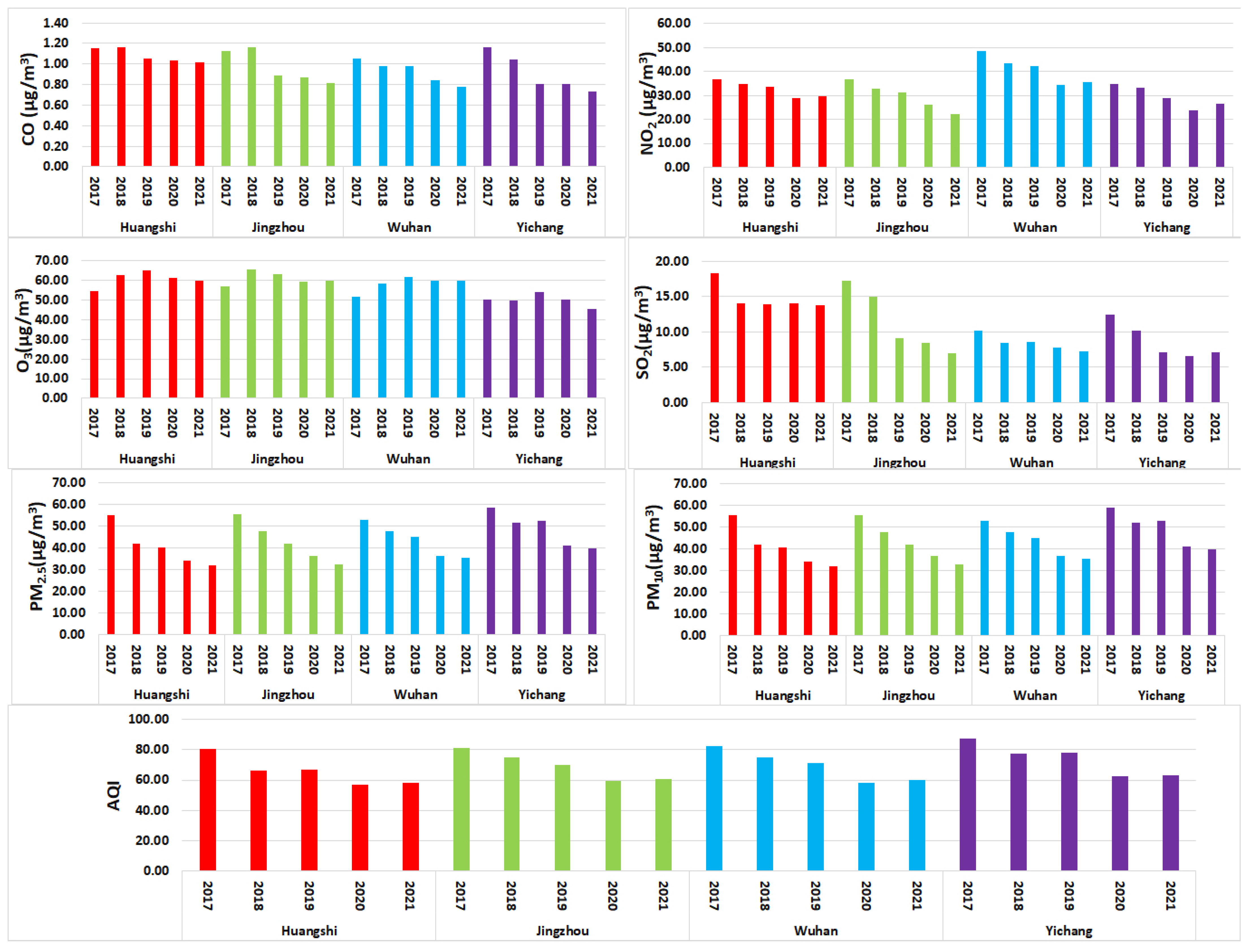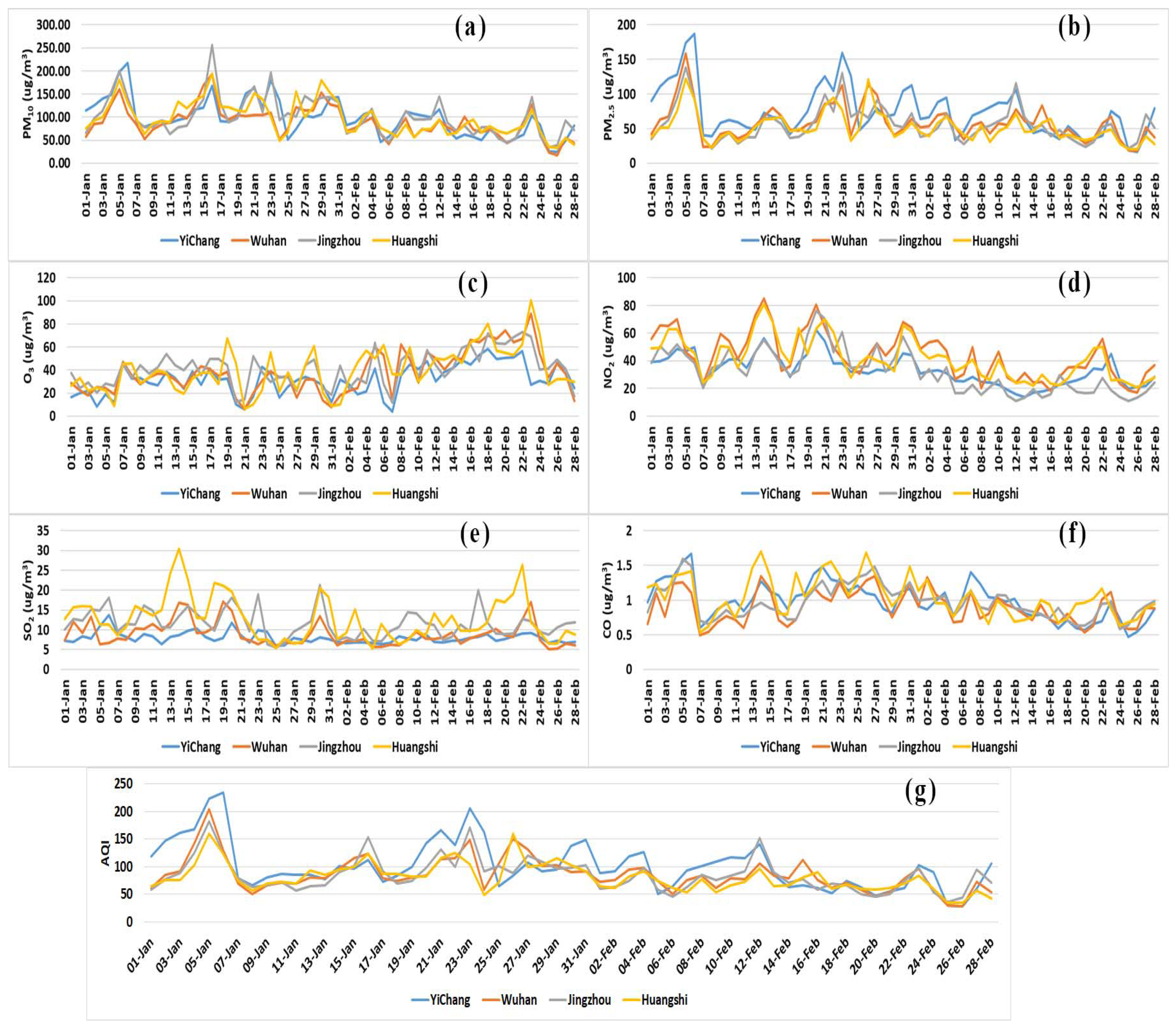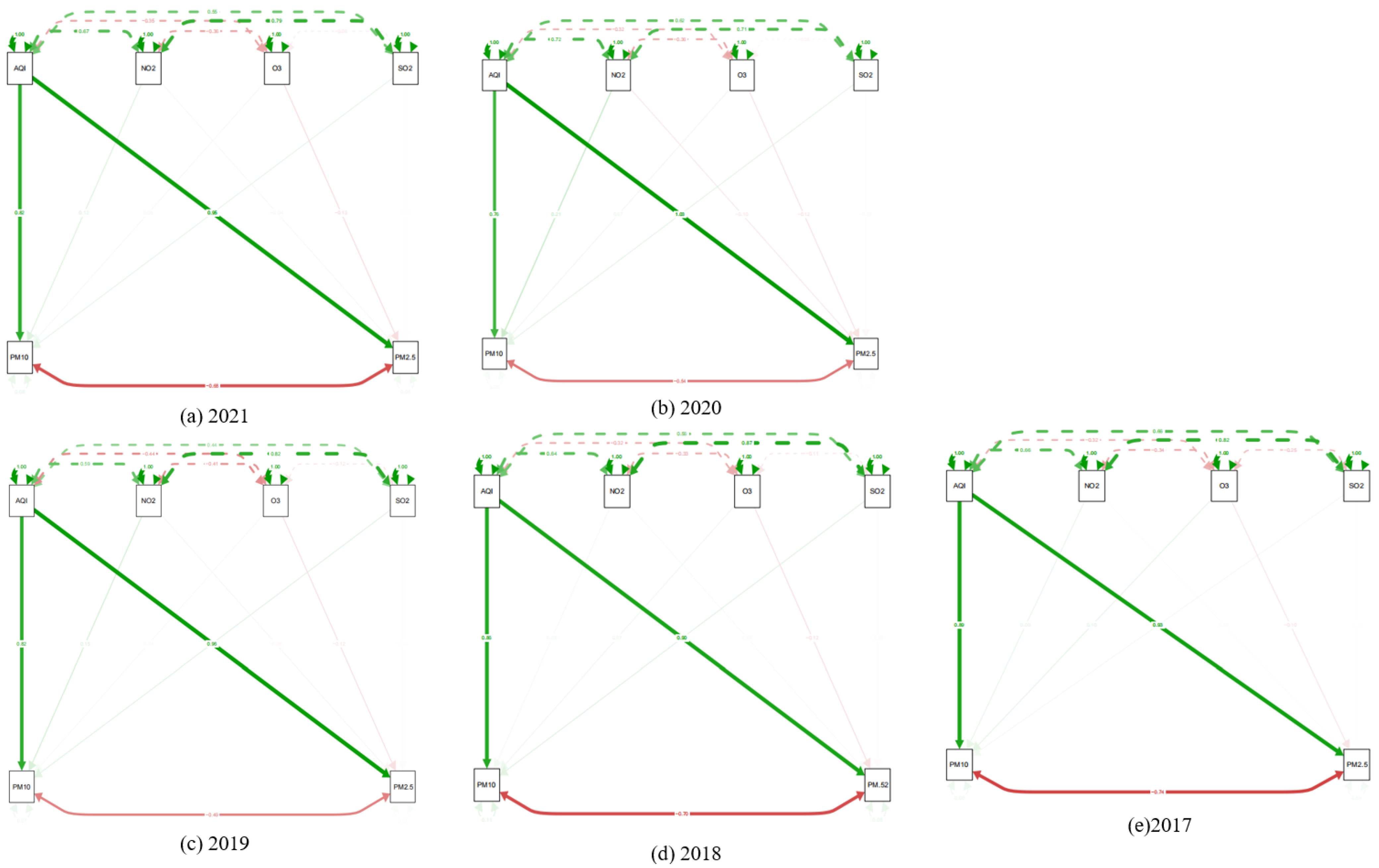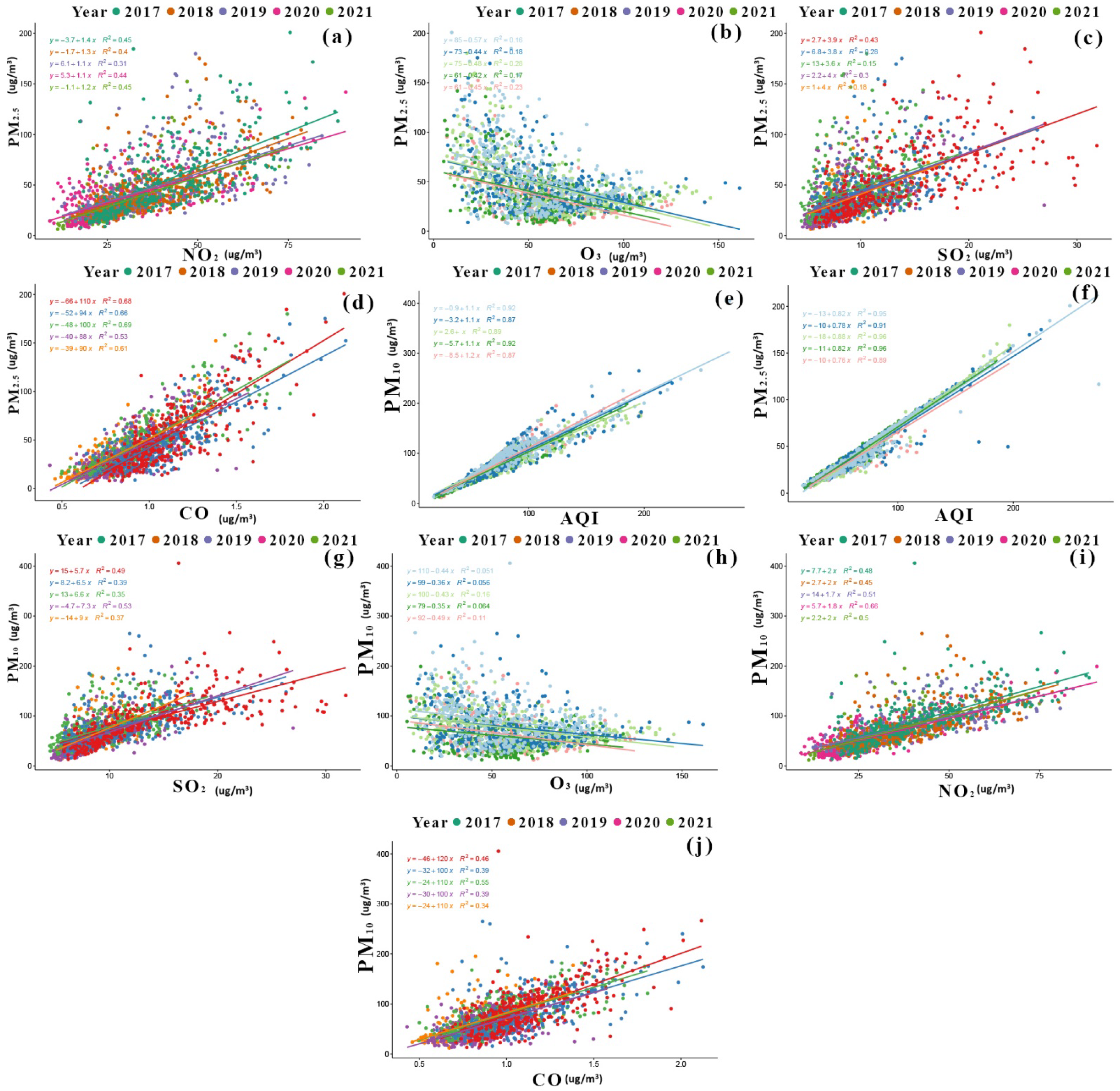Spatiotemporal Change of Air-Quality Patterns in Hubei Province—A Pre- to Post-COVID-19 Analysis Using Path Analysis and Regression
Abstract
:1. Introduction
2. Materials and Methods
2.1. Study Area Monitoring Stations
2.2. Air Pollutant Data
2.3. Regression and Path Analysis Model
2.4. Statistical Analysis
3. Results and Discussion
3.1. City-Wide Change in Air-Quality Patterns from 2017 to 2021
3.2. Daily Change in Air Pollutants during Active-COVID-19
3.3. Path Analysis Implementation
3.4. Regression Analysis Implementation
4. Conclusions
- This study verifies that the lockdown during the COVID-19 pandemic may have had both positive and negative effects on ambient air quality. However, due to limitations in the availability of data from all the air-monitoring stations, some stations’ data has been excluded, and thus, this outcome cannot be applied to all the stations.
- Further monitoring of stations can be improved if their locations are far from each other so that the overall air pollutants’ real concentration can be calculated across all parts of the city.
Author Contributions
Funding
Institutional Review Board Statement
Informed Consent Statement
Data Availability Statement
Acknowledgments
Conflicts of Interest
References
- Gautam, S.; Hens, L. COVID-19: Impact by and on the environment, health and economy. Environ. Dev. Sustain. 2020, 22, 4953–4954. [Google Scholar] [CrossRef]
- Li, L.; Li, Q.; Huang, L.; Wang, Q.; Zhu, A.; Xu, J.; Liu, Z.; Li, H.; Shi, L.; Li, R.; et al. Air quality changes during the COVID-19 lockdown over the Yangtze River Delta Region: An insight into the impact of human activity pattern changes on air pollution variation. Sci. Total Environ. 2020, 732, 139282. [Google Scholar] [CrossRef] [PubMed]
- Zalakeviciute, R.; Vasquez, R.; Bayas, D.; Buenano, A.; Mejia, D.; Zegarra, R.; Diaz, V.; Lamb, B. Drastic Improvements in Air Quality in Ecuador during the COVID-19 Outbreak. Aerosol Air Qual. Res. 2020, 20, 1783–1792. [Google Scholar] [CrossRef]
- Lian, X.; Huang, J.; Huang, R.-J.; Liu, C.; Wang, L.; Zhang, T. Impact of city lockdown on the air quality of COVID-19-hit of Wuhan city. Sci. Total Environ. 2020, 742, 140556. [Google Scholar] [CrossRef]
- Altuwayjiri, A.; Soleimanian, E.; Moroni, S.; Palomba, P.; Borgini, A.; De Marco, C.; Ruprecht, A.A.; Sioutas, C. The impact of stay-home policies during Coronavirus-19 pandemic on the chemical and toxicological characteristics of ambient PM2.5 in the metropolitan area of Milan, Italy. Sci. Total Environ. 2021, 758, 143582. [Google Scholar] [CrossRef] [PubMed]
- Elshorbany, Y.F.; Kapper, H.C.; Ziemke, J.R.; Parr, S.A. The Status of Air Quality in the United States during the COVID-19 Pandemic: A Remote Sensing Perspective. Remote Sens. 2021, 13, 369. [Google Scholar] [CrossRef]
- Menut, L.; Bessagnet, B.; Siour, G.; Mailler, S.; Pennel, R.; Cholakian, A. Impact of lockdown measures to combat Covid-19 on air quality over western Europe. Sci. Total Environ. 2020, 741, 140426. [Google Scholar] [CrossRef] [PubMed]
- Clemente, Á.; Yubero, E.; Nicolás, J.F.; Caballero, S.; Crespo, J.; Galindo, N. Changes in the concentration and composition of urban aerosols during the COVID-19 lockdown. Environ. Res. 2021, 203, 111788. [Google Scholar] [CrossRef]
- Zangari, S.; Hill, D.; Charette, A.T.; Mirowsky, J.E. Air quality changes in New York City during the COVID-19 pandemic. Sci. Total Environ. 2020, 742, 140496. [Google Scholar] [CrossRef]
- Agarwal, A.; Kaushik, A.; Kumar, S.; Mishra, R.K. Comparative study on air quality status in Indian and Chinese cities before and during the COVID-19 lockdown period. Air Qual. Atmos. Health 2020, 13, 1167–1178. [Google Scholar] [CrossRef]
- Bar, S.; Parida, B.R.; Mandal, S.P.; Pandey, A.C.; Kumar, N.; Mishra, B. Impacts of partial to complete COVID-19 lockdown on NO2 and PM2.5 levels in major urban cities of Europe and USA. Cities 2021, 117, 103308. [Google Scholar] [CrossRef]
- Stratoulias, D.; Nuthammachot, N. Air quality development during the COVID-19 pandemic over a medium-sized urban area in Thailand. Sci. Total Environ. 2020, 746, 141320. [Google Scholar] [CrossRef] [PubMed]
- Adam, M.G.; Tran, P.T.; Balasubramanian, R. Air quality changes in cities during the COVID-19 lockdown: A critical re-view. Atmos. Res. 2021, 264, 105823. [Google Scholar] [CrossRef]
- Wilder, B.; Charpignon, M.; Killian, J.A.; Ou, H.-C.; Mate, A.; Jabbari, S.; Perrault, A.; Desai, A.N.; Tambe, M.; Majumder, M.S. Modeling between-population variation in COVID-19 dynamics in Hubei, Lombardy, and New York City. Proc. Natl. Acad. Sci. USA 2020, 117, 25904–25910. [Google Scholar] [CrossRef]
- Ministry of Environmental Protection. Ambient Air Quality Standards (GB 3095-2012). 2012. Available online: http://www.zzemc.cn/em_aw/Content/GB3095-2012.pdf (accessed on 29 February 2012).
- Wright, S. On “Path analysis in genetic epidemiology: A critique”. Am. J. Hum. Genet. 1983, 35, 757–768. [Google Scholar]
- Mohan, M.; Kandya, A. An Analysis of the Annual and Seasonal Trends of Air Quality Index of Delhi. Environ. Monit. Assess. 2007, 131, 267–277. [Google Scholar] [CrossRef] [PubMed]
- Lau, H.; Khosrawipour, V.; Kocbach, P.; Mikolajczyk, A.; Schubert, J.; Bania, J.; Khosrawipour, T. The positive impact of lockdown in Wuhan on containing the COVID-19 outbreak in China. J. Travel Med. 2020, 27, taaa037. [Google Scholar] [CrossRef] [Green Version]
- Li, M.; Yin, H.; Jin, Z.; Zhang, H.; Leng, B.; Luo, Y.; Zhao, Y. Impact of Wuhan lockdown on the indications of cesarean delivery and newborn weights during the epidemic period of COVID-19. PLoS ONE 2020, 15, e0237420. [Google Scholar] [CrossRef]
- Goodsite, M.E.; Hertel, O.; Johnson, M.S.; Jørgensen, N.R. Urban Air Quality: Sources and Concentrations. In Air Pollution Sources, Statistics and Health Effects; Springer: New York, NY, USA, 2021. [Google Scholar] [CrossRef]
- Guo, H.; Yang, C.; Liu, X.; Li, Y.; Meng, Q. Simulation evaluation of urban low-carbon competitiveness of cities within Wuhan city circle in China. Sustain. Cities Soc. 2018, 42, 688–701. [Google Scholar] [CrossRef]
- Elsaid, A.M.; Ahmed, M.S. Indoor Air Quality Strategies for Air-Conditioning and Ventilation Systems with the Spread of the Global Coronavirus (COVID-19) Epidemic: Improvements and Recommendations. Environ. Res. 2021, 199, 111314. [Google Scholar] [CrossRef] [PubMed]
- Yang, Q.; Wang, B.; Wang, Y.; Yuan, Q.; Jin, C.; Wang, J.; Li, S.; Li, M.; Li, T.; Liu, S.; et al. Global air quality change during COVID-19: A synthetic analysis of satellite, reanalysis and ground station data. Environ. Res. Lett. 2021, 16, 074052. [Google Scholar] [CrossRef]
- Lin, R.; Lin, S.; Yan, N.; Huang, J. Do prevention and control measures work? Evidence from the outbreak of COVID-19 in China. Cities 2021, 118, 103347. [Google Scholar] [CrossRef] [PubMed]
- Jephcote, C.; Hansell, A.L.; Adams, K.; Gulliver, J. Changes in air quality during COVID-19 ‘lockdown’ in the United Kingdom. Environ. Pollut. 2021, 272, 116011. [Google Scholar] [CrossRef] [PubMed]
- Ali, S.M.; Malik, F.; Anjum, M.S.; Siddiqui, G.F.; Anwar, M.N.; Lam, S.S.; Nizami, A.-S.; Khokhar, M.F. Exploring the linkage between PM2.5 levels and COVID-19 spread and its implications for socio-economic circles. Environ. Res. 2021, 193, 110421. [Google Scholar] [CrossRef] [PubMed]
- Ghahremanloo, M.; Lops, Y.; Choi, Y.; Mousavinezhad, S. Impact of the COVID-19 outbreak on air pollution levels in East Asia. Sci. Total Environ. 2021, 754, 142226. [Google Scholar] [CrossRef]
- Bao, R.; Zhang, A. Does lockdown reduce air pollution? Evidence from 44 cities in northern China. Sci. Total Environ. 2020, 731, 139052. [Google Scholar] [CrossRef]
- Brimblecombe, P. Visibility Driven Perception and Regulation of Air Pollution in Hong Kong, 1968–2020. Environments 2021, 8, 51. [Google Scholar] [CrossRef]
- Hang, Y.; Wang, Q.; Wang, Y.; Su, B.; Zhou, D. Industrial SO2 emissions treatment in China: A temporal-spatial whole process decomposition analysis. J. Environ. Manag. 2019, 243, 419–434. [Google Scholar] [CrossRef]





| Air Quality Index Range | Air Quality Level | Air Quality Category | Representative Color | Impacts on Human Health and Recommended Actions |
|---|---|---|---|---|
| 0–50 | Level I | Superior | Green | The air quality is satisfactory. There is basically no air pollution, and no impact on human activities |
| 51–100 | Level II | Good | Yellow | The air quality is acceptable. There are certain air pollutants that may cause health issues to a small number of people who should reduce outdoor activities. |
| 101–150 | Level III | Mild Pollution | Orange | Symptoms in susceptible people would intensify, and healthy people would show irritation symptoms. Elderly people and children should avoid long duration of high-intensity outdoor exercises. |
| 151–200 | Level IV | Moderate Pollution | Red | Symptoms in susceptible people would further intensify, and the breathing of healthy people would be affected. Elderly people and children should avoid outdoor sports. |
| 201–300 | Level V | Heavy Pollution | Purple | Ordinary people would show symptoms. Elderly people and children should avoid outdoor sports. The general population should reduce outdoor activities. |
| >300 | Level VI | Severe Pollution | Maroon | Obvious and strong symptoms would appear, and all groups of people should avoid outdoor activities. |
| Year | Method | Statistical Analysis of Air Pollutants | ||||||
|---|---|---|---|---|---|---|---|---|
| AQI | CO | NO2 | O3 | PM10 | PM2.5 | SO2 | ||
| 2021 | Max | 259.63 | 2.70 | 99.29 | 153.04 | 368.88 | 208.42 | 80.96 |
| Min | 15.96 | 0.20 | 2.96 | 1.50 | 4.17 | 2.00 | 1.21 | |
| Mean | 60.37 C | 0.82 E | 30.92 C | 56.83 AB | 63.75 C | 35.42 C | 8.61 D | |
| Std. | 29.71 | 0.28 | 15.76 | 26.53 | 37.45 | 23.76 | 4.87 | |
| Median | 55.41 | 0.79 | 27.75 | 54.92 | 55.04 | 30.33 | 7.46 | |
| 2020 | Max | 238.75 | 7.66 | 143.38 | 155.79 | 255.21 | 189.13 | 160.86 |
| Min | 12.38 | 0.13 | 1.92 | 1.88 | 5.29 | 2.17 | 1.00 | |
| Mean | 59.23 C | 0.87 D | 29.84 C | 57.87 A | 58.90 C | 37.25 C | 8.76 D | |
| Std. | 30.46 | 0.30 | 17.53 | 25.97 | 33.86 | 25.40 | 6.47 | |
| Median | 53.54 | 0.84 | 25.54 | 57.57 | 51.90 | 30.71 | 7.17 | |
| 2019 | Max | 346.33 | 2.78 | 121.73 | 181.00 | 340.08 | 296.33 | 59.21 |
| Min | 15.54 | 0.13 | 3.74 | 3.22 | 8.95 | 3.00 | 1.04 | |
| Mean | 72.02 B | 0.94 C | 36.04 B | 60.67 A | 74.33 B | 45.79 B | 9.37 C | |
| Std. | 35.97 | 0.33 | 18.55 | 33.90 | 38.00 | 32.09 | 5.71 | |
| Median | 63.46 | 0.90 | 31.96 | 57.54 | 66.22 | 36.96 | 8.00 | |
| 2018 | Max | 353.83 | 4.43 | 135.61 | 212.96 | 465.08 | 248.04 | 68.54 |
| Min | 11.25 | 0.15 | 3.79 | 1.57 | 6.00 | 3.42 | 1.06 | |
| Mean | 73.74 B | 1.06 B | 37.85 B | 58.28 A | 78.02 B | 47.69 B | 10.82 B | |
| Std. | 38.92 | 0.36 | 18.52 | 30.50 | 46.45 | 31.57 | 6.62 | |
| Median | 63.42 | 1.00 | 33.42 | 55.04 | 65.64 | 39.08 | 9.42 | |
| 2017 | Max | 478.17 | 5.29 | 137.42 | 217.17 | 743.25 | 351.04 | 132.00 |
| Min | 12.33 | 0.16 | 2.00 | 2.08 | 6.31 | 2.88 | 1.04 | |
| Mean | 83.06 A | 1.11 A | 41.47 A | 52.81 B | 91.16 A | 55.11 A | 13.40 A | |
| Std. | 44.87 | 0.35 | 20.48 | 28.39 | 53.16 | 37.19 | 9.53 | |
| Median | 74.58 | 1.06 | 36.71 | 48.67 | 82.70 | 46.45 | 11.08 | |
| 2021 | 2020 | 2019 | |||||||
|---|---|---|---|---|---|---|---|---|---|
| β Coefficient | Std. Error | Multiple R2 | β Coefficient | Std. Error | Multiple R2 | β Coefficient | Std. Error | Multiple R2 | |
| AQI | 0.949 | 0.013 | 0.917 | 0.866 | 0.017 | 0.965 | 0.868 | 0.019 | 0.933 |
| 0.317 | 0.04 | 0.466 | 0.037 | 0.363 | 0.069 | ||||
| 0.069 | 0.013 | 0.097 | 0.015 | 0.042 | 0.018 | ||||
| 1.092 | 0.152 | 1.089 | 0.15 | 1.238 | 0.288 | ||||
| AQI | 0.801 | 0.007 | 0.949 | 0.861 | 0.009 | 0.98 | 0.866 | 0.009 | 0.977 |
| −0.073 | 0.023 | −0.162 | 0.021 | −0.096 | 0.034 | ||||
| −0.13 | 0.007 | −0.122 | 0.009 | −0.11 | 0.009 | ||||
| −0.6 | 0.087 | −0.203 | 0.084 | −0.167 | 0.143 | ||||
Publisher’s Note: MDPI stays neutral with regard to jurisdictional claims in published maps and institutional affiliations. |
© 2021 by the authors. Licensee MDPI, Basel, Switzerland. This article is an open access article distributed under the terms and conditions of the Creative Commons Attribution (CC BY) license (https://creativecommons.org/licenses/by/4.0/).
Share and Cite
Aamir, M.; Li, Z.; Bazai, S.; Wagan, R.A.; Bhatti, U.A.; Nizamani, M.M.; Akram, S. Spatiotemporal Change of Air-Quality Patterns in Hubei Province—A Pre- to Post-COVID-19 Analysis Using Path Analysis and Regression. Atmosphere 2021, 12, 1338. https://doi.org/10.3390/atmos12101338
Aamir M, Li Z, Bazai S, Wagan RA, Bhatti UA, Nizamani MM, Akram S. Spatiotemporal Change of Air-Quality Patterns in Hubei Province—A Pre- to Post-COVID-19 Analysis Using Path Analysis and Regression. Atmosphere. 2021; 12(10):1338. https://doi.org/10.3390/atmos12101338
Chicago/Turabian StyleAamir, Muhammad, Zeyun Li, Sibghatullah Bazai, Raja Asif Wagan, Uzair Aslam Bhatti, Mir Muhammad Nizamani, and Shakeel Akram. 2021. "Spatiotemporal Change of Air-Quality Patterns in Hubei Province—A Pre- to Post-COVID-19 Analysis Using Path Analysis and Regression" Atmosphere 12, no. 10: 1338. https://doi.org/10.3390/atmos12101338
APA StyleAamir, M., Li, Z., Bazai, S., Wagan, R. A., Bhatti, U. A., Nizamani, M. M., & Akram, S. (2021). Spatiotemporal Change of Air-Quality Patterns in Hubei Province—A Pre- to Post-COVID-19 Analysis Using Path Analysis and Regression. Atmosphere, 12(10), 1338. https://doi.org/10.3390/atmos12101338









